Scottish Employer Perspectives Survey: 2019
Official statistics release covering the key statistics in the Scottish Employer Perspectives Survey (EPS) 2019.
This document is part of a collection
Entry to work
EPS questions on ‘entry to work’ topics include vacancies and recruitment practices, and employers’ attitudes and actions towards supporting an inclusive labour market.
Vacancies
48% of employers have had at least one vacancy in the previous 12 months, and 43% have recruited staff.
Larger employers are more active in the labour market. 98% of employers with 100 or more staff have had a vacancy and 96% have recruited one or more employees, compared to 23% and 19% respectively of employers with 2 to 4 staff.
Figure 2 shows that ‘Public administration’ is the sector with the highest proportion of establishments with vacancies (82%); ‘Primary sector and utilities’ has the lowest proportion of establishments with vacancies (32%).
Figure 2: Proportion of establishments with vacancies in the last 12 months, by sector
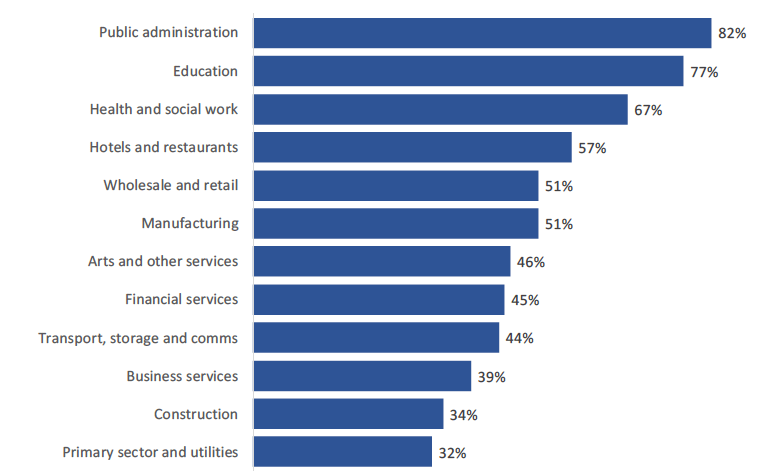
Base population: 2,652
Recruitment methods and related issues
The majority of employers who recruited in the 12 months prior to the study used multiple recruitment methods.
20% of employers who have recruited in the preceding year used only a single approach to recruitment. This is an increase from 18% in 2016.
‘Word of mouth or personal recommendation’ is the most commonly used recruitment approach by employers with a vacancy (78%), compared to 77% in 2016. Other internal resources[5] such as their ‘own social media’ (56%) or ‘website’ (53%) are also commonly used, compared to 47% and 55% in 2016 respectively. 33% of employers who have experienced vacancies use only ‘internal resources’; an increase from 29% in 2016. 12% use only ‘word of mouth or personal recommendation’ to advertise vacancies; an increase from 10% in 2016.
Relevant work experience remains the attribute most commonly sought by employers in candidates for job roles, with 62% rating it as a ‘significant’ or ‘critical’ factor as shown in Table 1.
Table 1: Importance of factors looked for in recruitment
| Factor | Proportion who consider factor ‘Critical’ or ‘Significant’ |
|---|---|
| Having relevant work experience | 62% |
| Having Maths and English to at least SCQF level 4 or 5[6] |
51% |
| Having a relevant vocational qualification | 46% |
| Having particular academic qualifications such as Nationals, Highers or a degree | 35% |
Base population: 2,652
Equalities and diversity in recruitment
51% of employers who have experienced a vacancy collected information to monitor the diversity of applicants.
For employers with 100+ employees, 77% monitor the diversity of applicants (Figure 3). The practice is more common in the public sector (81%) where Public Sector Equality Duty (PSED) rules require the collection of such information.
47% of employers who have experienced a vacancy advertised a role that would be suited to flexible working.
Generally, larger employers are more likely to advertise jobs that allow flexible working arrangements (Figure 3).
Across most establishment sizes, a higher proportion of employers who have had a vacancy monitor the diversity of applicants than offer applicants the ability to request flexible working.
Figure 3: Monitoring the diversity of applicants and advertising jobs which allow flexible working, by establishment size
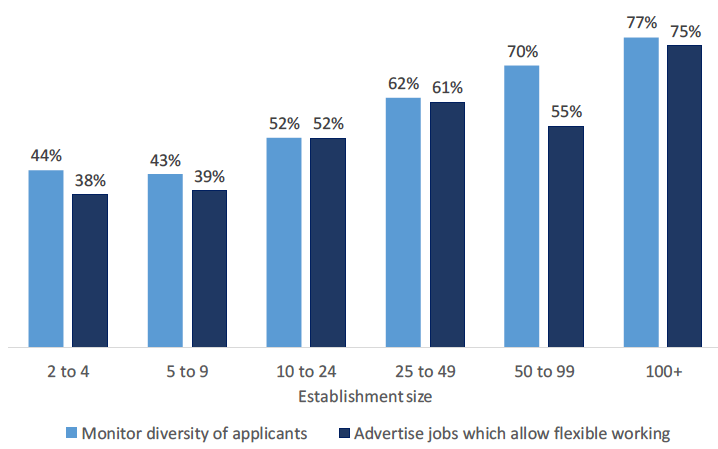
Base population: 1,729
In terms of specific measures, 13% of employers with a vacancy use ‘positive action’[7] and 8% use ‘blind or no name recruitment’[8]. Table 2 shows other attributes which are used by employers to promote equality and diversity.
Awareness of ‘positive action’ is higher amongst public and voluntary sector employers with a vacancy than amongst private sector employers with a vacancy (76% and 76%, compared to 63% respectively). The largest employers with a vacancy are more likely to use ‘positive action’: 19% of those with 100+ staff compared to 11% of those with 2 to 4 staff.
82% of employers with a vacancy could not identify any specific action they have taken to attract and encourage a diverse range of applicants. 73% of employers with a vacancy who currently monitor the diversity of applicants were also not able to identify any such action.
Table 2: Percentage of employers with a vacancy who have used specific recruitment practices in last year
| Recruitment practice | Private | Voluntary | Public | All employers |
|---|---|---|---|---|
| Awareness of Positive Action | 63% | 76% | 76% | 65% |
| Monitoring equality and diversity of applicants | 43% | 73% | 81% | 51% |
| Flexible working vacancies advertised | 42% | 66% | 70% | 47% |
| Encouraged diverse range of applicants | 7% | 30% | 33% | 13% |
| Use of Positive Action | 11% | 19% | 16% | 13% |
| Use of ‘blind’ or ‘no name’ recruitment | 4% | 18% | 26% | 8% |
Base population: 1,729
Gender Pay Gap legislation
58% of employers who are required to report on their Gender Pay Gap have not changed their recruitment practices in relation to equality and diversity.
Since the previous wave of EPS research, Gender Pay Gap legislation has come into force. From 2018, public, private and voluntary sector employers with 250 or more employees have been required to publish information on their Gender Pay Gap[9].
74% of all employers are aware of this Gender Pay Gap legislation. 95% of employers with 250+ employees (and therefore required to report) are aware of this Gender Pay Gap legislation.
Amongst those employers who are aware of the Gender Pay Gap legislation and have 250+ employees, 58% have made no specific changes to their recruitment practices in relation to equality and diversity, 26% had made at least one change and 16% did not know whether they had.
Specific changes include increasing the transparency of salaries / salary bands; altering the salaries of positions; recruiting more women; making changes to personnel on recruitment panels; altering the language used in job adverts; raising awareness; and implementing 'blind' or 'no name' recruitment practices.
Recruiting young and older people
60% of employers who recruited in the preceding year recruited a young person (aged under 25).
This has been decreasing since 2014, as shown in Table 3.
42% of employers who recruited in the preceding year recruited an older person (aged 50 or over).
This has been increasing since 2016, as shown in Table 3.
Table 3: Recruitment of young and older people, 2014, 2016 and 2019
| Recruitment | Proportion of all recruiting employers | ||
|---|---|---|---|
| 2014 | 2016 | 2019 | |
| Young people (aged under 25) | 66% | 64% | 60% |
| Older people (aged over 50) | 29% | 31% | 42% |
Base population: 2,440 (2014), 2,470 (2016), 1,611 (2019)
For establisments with 2-4 employees who have recruited one or more employees, 42% have recruited a young person in the last year compared to 34% who have recruited an older person. For employers with 100+ employees, 88% have recruited a young person in the last year and 77% have recruited an older person (Figure 4).
Figure 4: Proportion of recruiting employers who have recruited young and older people in the last year, by establishment size
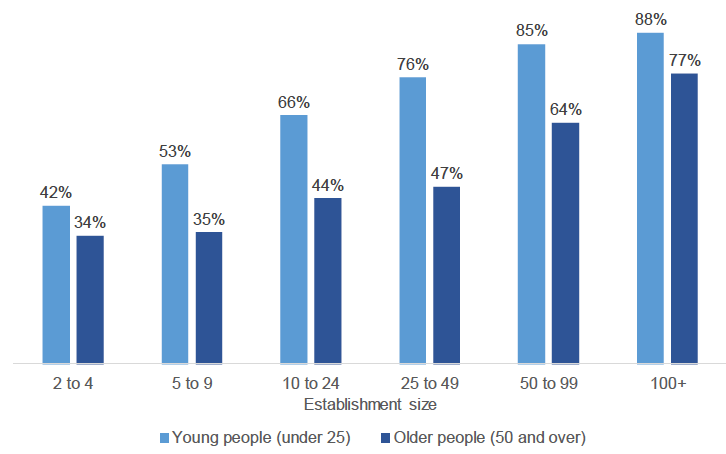
Base population: 1,611
The ‘Hotels and Restaurants’ sector has the highest proportion of recruiting employers who have recruited a young person (76%); ‘Financial Services’ and ‘Construction’ are the sector with the lowest proportions (46%).
As shown in Figure 5, ‘Manufacturing’ is the sector with the highest proportion of recruiting employers that have recruited an older person (57%); ‘Construction’ is the sector with the lowest proportion (26%).
Employers who monitor the diversity of their applicants, use positive action, blind recruitment, offer flexible posts and / or encour ounterparts who have not adopted these recruitment practices.
Figure 5: Proportion of recruiting employers who have recruited young or older people in the last year, by sector
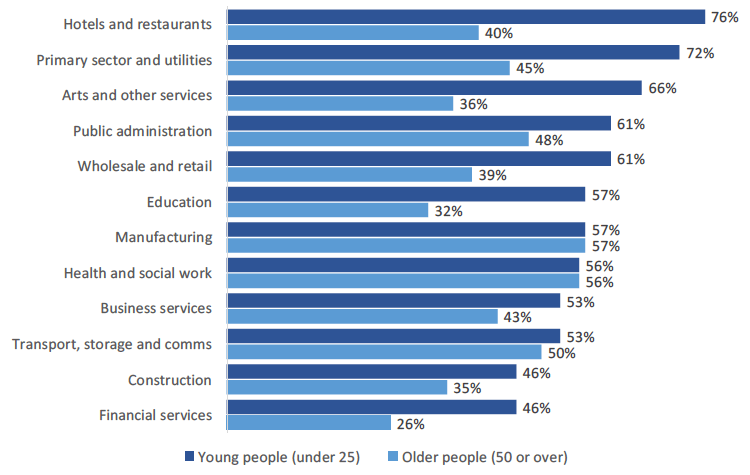
Base population: 1,611
Recruitment directly from education
In the last 2 to 3 years, 30% of employers recruited an employee directly from education.
This is a decrease from 2016, as shown in Table 4.
Directly from education includes recruiting an employee to their first job from a school, college or university in Scotland. Overall, employers were less likely to recruit an employee directly from education than they were in 2016. The percentage of employers recruiting from schools, colleges or universities was 20%, 12% and 11% respectively.
Table 4: Recruitment of education leavers, 2014, 2016 and 2019
| Recruitment | Proportion of all employers | ||
|---|---|---|---|
| 2014 | 2016 | 2019 | |
| Any education leaver | 32% | 32% | 30% |
| School leaver | 19% | 19% | 20% |
| College leaver | 11% | 11% | 12% |
| University leaver | 13% | 14% | 11% |
Base population: 4,015 (2014), 4,009 (2016), 2,652 (2019)
Preparedness for work
The majority of employers find their education leavers to be ‘well’ or 'very well' prepared.
This level of preparedness varies with the education sector. 58% of employers who recruited a leaver from a Scottish school, 74% who recruited a leaver from a Scottish college and 78% who recruited a leaver from a Scottish university felt they were ‘well prepared’ or ‘very well prepared’. These are decreases from the 2016 survey (Table 5).
Table 5: Preparedness of education leavers for work, 2014, 2016 and 2019
| Education leaver | Proportion of employers who felt the leaver was very well / well prepared | ||
|---|---|---|---|
| 2014 | 2016 | 2019 | |
| School leaver | 63% | 65% | 58% |
| College leaver | 81% | 80% | 74% |
| University leaver | 88% | 84% | 78% |
| Base population: School leaver recruiters – | 1,101 | 1,052 | 779 |
| College leaver recruiters – | 754 | 707 | 538 |
| University leaver recruiters – | 840 | 827 | 401 |
Work placements
36% of employers provided any type of work placement in the last 12 months.
Although the proportion of employers offering any type[10] of work placements in Scotland has decreased to 36% in 2019 (by around 3 percentage points since 2016), those who do so are offering them to more individuals. In total, employers offering work placements each took an average of just over six individuals on to a placement in the 12 months preceding the survey. Almost 333,000 placements were offered to individuals by employers, an increase of 6% from the number of placements in 2016.
34% of employers who provided work placements had gone on to recruit a trainee to a permanent or long term paid role, in most cases directly following their placement.
Work placements were more common among larger employers, and among those in the public and voluntary sectors.
Variation was considerable across industrial sectors, with employers in the ‘Education’ and ‘Health and social work’ sectors most likely to have offered work placements (77% and 68% respectively). This can be compared to ‘Construction’ sector employers, among whom just 21% had offered work placements (Figure 6).
The main barriers cited by those who did not offer work placement opportunities were structural (68%). For example they had no suitable roles (38%) or lacked the time and resources to do so (20%). Lack of awareness was a barrier for 21% of employers, particularly among smaller employers, i.e. those with less than 25 staff.
Figure 6: Proportion of employers who have any type of work placements by sector, 2019
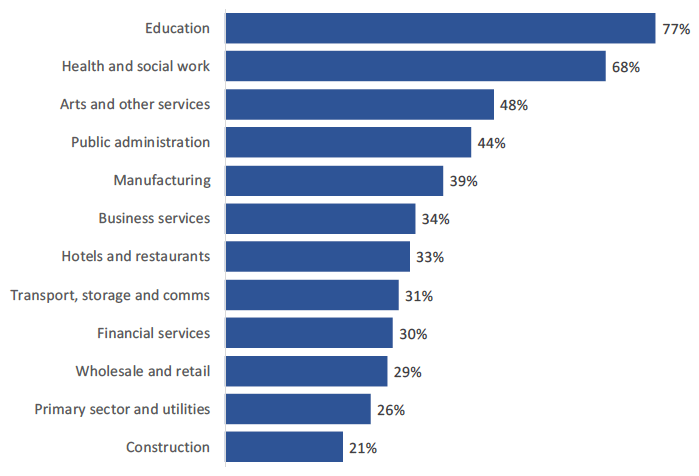
Base population: 2,652
Contact
Email: peter.phillips@gov.scot
There is a problem
Thanks for your feedback